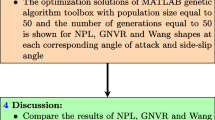Abstract
The major methods to investigate the airbags cushion system are experimental method, thermodynamic method and finite element method (FEM). Airbags cushion systems are very complicated and very difficult to be investigated thoroughly by such methods. For experimental method, it is nearly impossible to completely analyze and optimize the cushion characteristics of airbags of airborne vehicle because of charge issue, safety concern and time constraint. Thermodynamic method fails to take the non-linear effects of large airbag deformation and varied contact conditions into consideration. For finite element method, the FE model is usually complicated and the calculation takes tens of hours of CPU time. As a result, the optimization of the design based on a nonlinear model is very difficult by traditional iterative approach method. In this paper, a model based on FEM and control volume method is proposed to simulate landing cushion process of airborne vehicle with airbags cushion system in order to analyze and optimize the parameters in airbags cushion system. At first, the performance of airbags cushion system model is verified experimentally. In airdrop test, accelerometers are fixed in 4 test points distributed over engine mount, top, bottom and side armor plate of hull to obtain acceleration curves with time. The simulation results are obtained under the same conditions of the airdrop test and the simulation results agree very well with the experimental results, which indicate the established model is valid for further optimization. To optimize the parameters of airbags, equivalent response model based on Latin Hypercube DOE and radial basis function is employed instead of the complex finite element model. Then the optimal results based on equivalent response model are obtained using simulated annealing algorithm. After optimization, the maximal acceleration of airborne vehicle landing reduces 19.83%, while the energy absorption by airbags increases 7.85%. The performance of the airbags cushion system thus is largely improved through optimization, which indicates the proposed method has the capability of solving the parameter optimization problem of airbags cushion system for airborne vehicle.
Similar content being viewed by others
References
TAYLOR A P. Investigation of the application of airbag technology to provide a softlanding capability for military heavy airdrop[G]. AIAA 2001-2046, 2001: 284–292.
EWING E G, BIXBY H W, KNACKE T W. Recovery system design guide[M]. Beijing: Aviation Industry Press, 1988.
LE Yongxiang. Numerical simulation and optimal design of the process of airbag landing[D]. Changsha: Hunan University, 2010. (in Chinese)
ESGAR J B, MORGAN W C. Analytical study of soft landings on gas-filled bags[R]. NASA Technical Report R-75, Cleveland: Lewis Research Center, 1960.
BROWNING A C. A theoretical approach to air bag shock absorber design[R]. Technical Note No. Mech. Eng. 369, London: Her Majesty’s Stationery Office, 1963.
GARDINIER D J, TAYLOR A P. Design and testing of the K-1 Reusable Launch Vehicle landing system airbags[G]. AIAA 99-1757, 1999: 418–427.
WAN Zhimin, XIE Zhimin. Test research on landing characteristics of aerocraft utilizing airbag as shock absorbers[J]. Test Technology and Testing Machine, 2003, 43(1): 9–12. (in Chinese)
WANG Yawei, YANG Chunxin, KE Peng. Airbag cushion process simulation for cargo airdrop system[J]. Journal of System Simulation, 2007, 19(14): 3 176–3 179. (in Chinese)
WANG J T, NEFSKE J D. A new CAL3D airbag inflation model[G]. SAE Paper No. 880654, 1988.
WANG Hongyan, HAO Guixiang. Research on matching and evaluating for recovery system of airborne vehicle based on FEM[C]//The 7th China CAE Annual Conference, Kunming, China, 2011: 120–127. (in Chinese)
NIU Shibo, WANG Hongyan, CHI Baoshan. Optimal design of airbag cushion process for airdropping equipment[J]. Journal of Academy of Armored Force Engineering, 2010, 24(5): 36–40. (in Chinese)
WANG Xucheng. Finite element method[M]. Beijing: Tsinghua University Press, 2003. (in Chinese)
LI Jianyang, WANG Hongyan, HAO Guixiang. Simulation of landing process base on explicit finite element method[J]. Journal of Academy of Armored Force Engineering, 2010, 24(3): 25–28. (in Chinese)
DU Zhiqi, SHAO Pengli. Dynamic finite element simulation of the aluminum alloy hull at landing[J]. ACTA ARMAMENTARII, 2009, 30(1): 1–4. (in Chinese)
MYERS R H, MONTGOMERY D C. Response surface methodology: process and product optimization using designed experiments[M]. New York: John Wiley & Sons, 1976.
ZHANG Yi, LI Yanyan, XU Jinxiang. Research on trajectory parameter optimization based on orthogonal design[J]. Journal of Projectiles, Rockets, Missiles and Guidance, 2008, 28(5): 188–190. (in Chinese)
MCKAY M D, BECKMAN R J, CONOVER W J. A comparison of three methods for selecting values of input variables from a computer code[J]. Technometrics, 1979, 21(2): 239–245.
DOU Yifang, LIU Fei, ZHANG Weihua. Research on comparative analysis is of response surface methods[J]. Journal of Engineering Design, 2007, 14(5): 359–363. (in Chinese)
KIRKPATRICK S, GELATT C D. Optimization by simulated annealing[J]. Science, 1983, 220: 671–680.
Author information
Authors and Affiliations
Corresponding authors
Additional information
WANG Hongyan, born in 1965, is currently a professor at Academy of Armored Force Engineering, China. He received his PhD degree from Jilin University of Technology, China, in 1998. His main research interests include Vehicles Dynamics.
HONG Huangjie, born in 1985, is currently a PhD candidate at Academy of Armored Force Engineering, China.
HAO Guixiang, born in 1980, is currently a PhD candidate at Academy of Armored Force Engineering, China.
DENG Huaxia, born in 1982, is currently a professor at Hefei University of Technology, China. He received his PhD degree from University of Liverpool, UK, in 2011. His main research interests include dynamic analysis, smart materials and structures.
RUI Qiang, born in 1979, is currently a lecturer at Academy of Armored Force Engineering, China. He received his PhD degree from Academy of Armored Force Engineering, China, in 2009. His main research interests include vehicles structure analysis.
LI Jianyang, born in 1986, is currently a PhD candidate at Academy of Armored Force Engineering, China.
Rights and permissions
About this article
Cite this article
Wang, H., Hong, H., Hao, G. et al. Characteristic verification and parameter optimization of airbags cushion system for airborne vehicle. Chin. J. Mech. Eng. 27, 50–57 (2014). https://doi.org/10.3901/CJME.2014.01.050
Received:
Revised:
Accepted:
Published:
Issue Date:
DOI: https://doi.org/10.3901/CJME.2014.01.050



